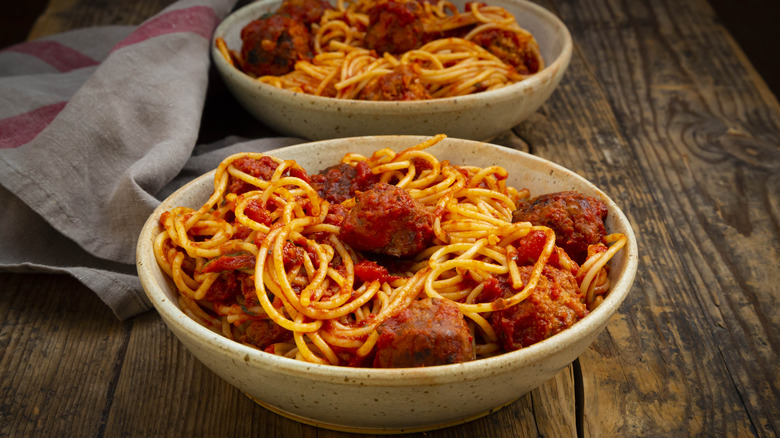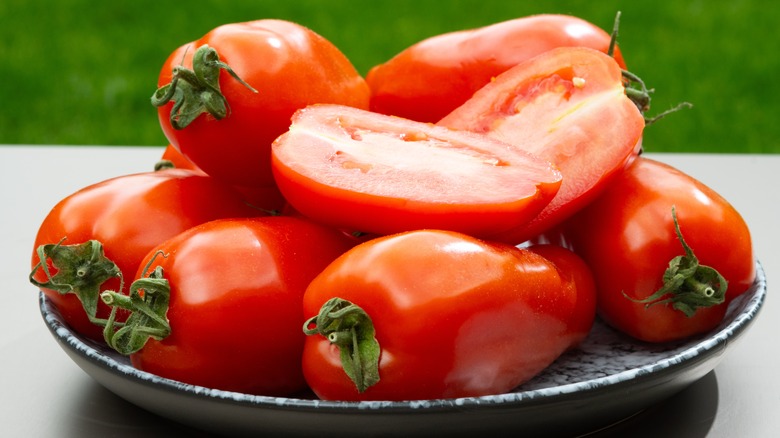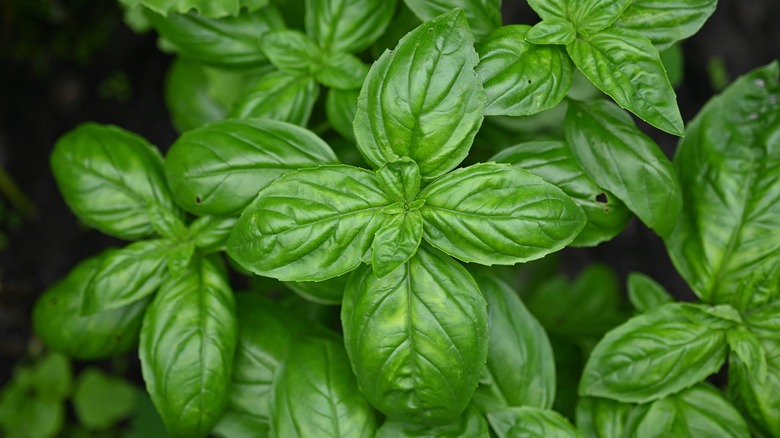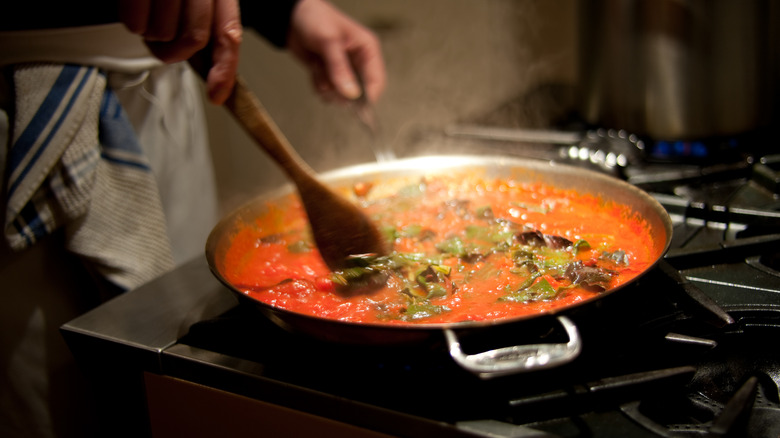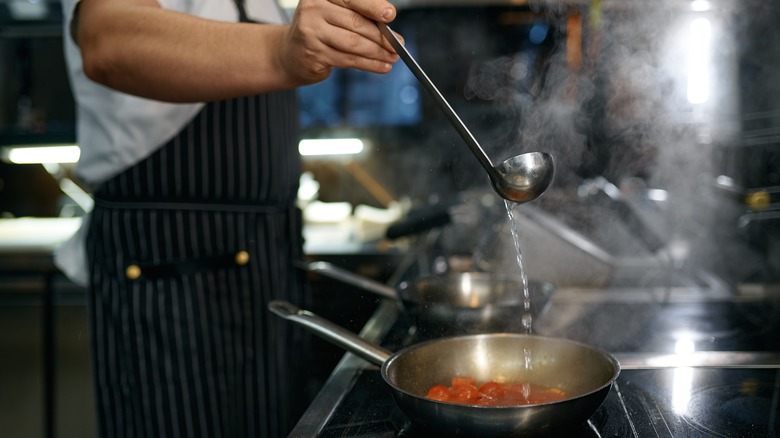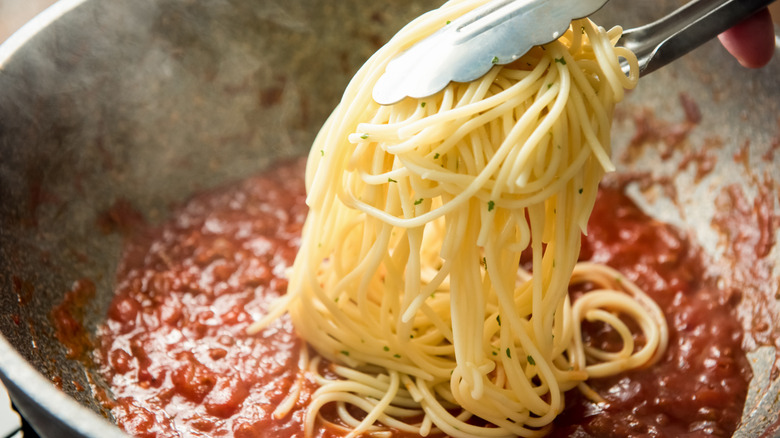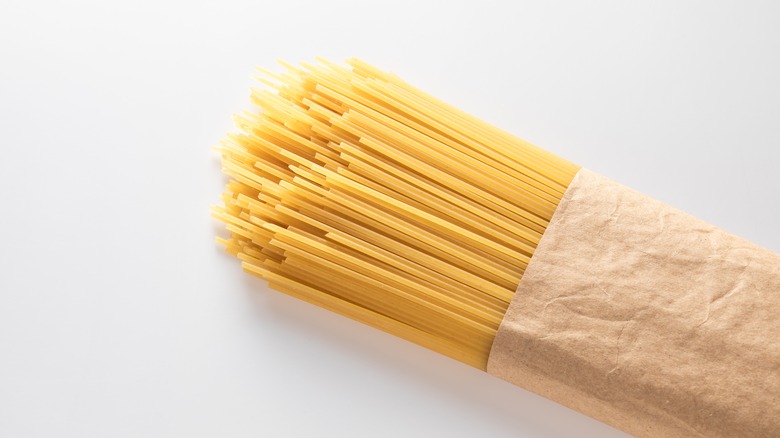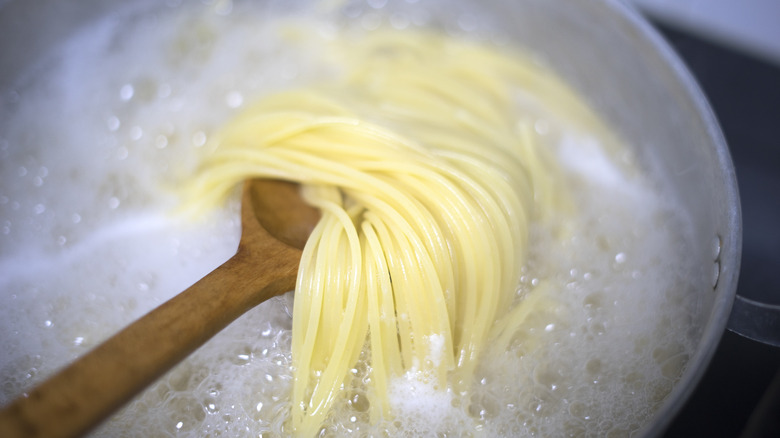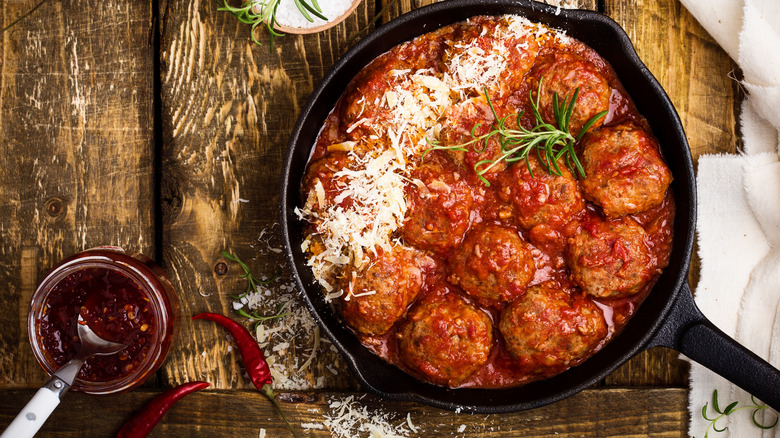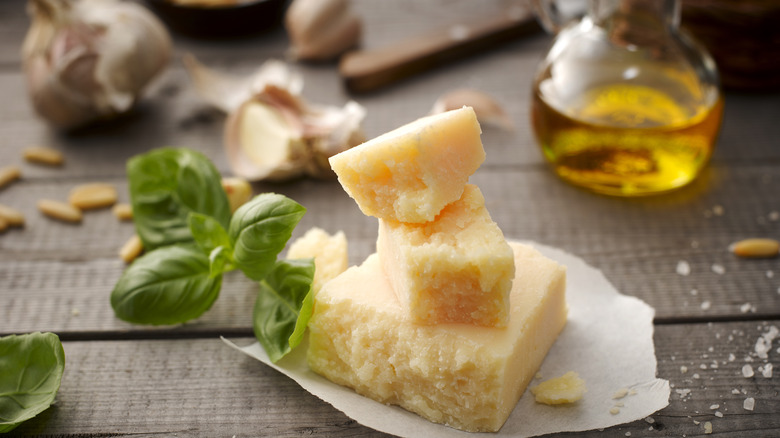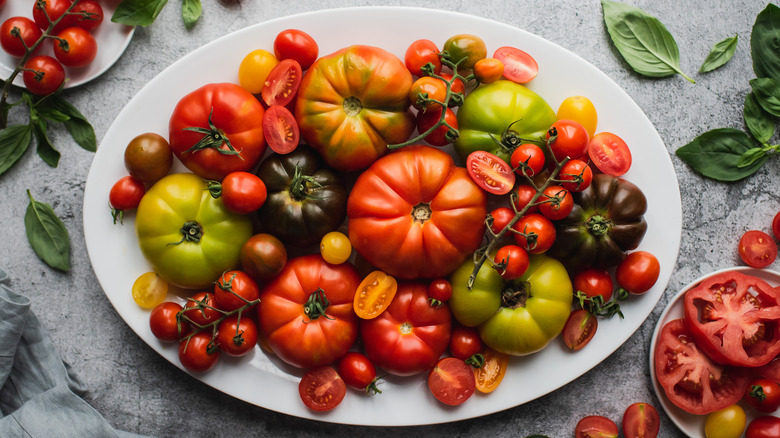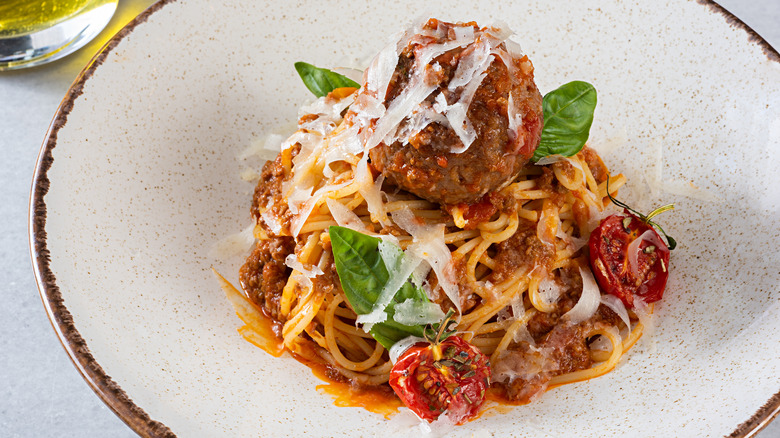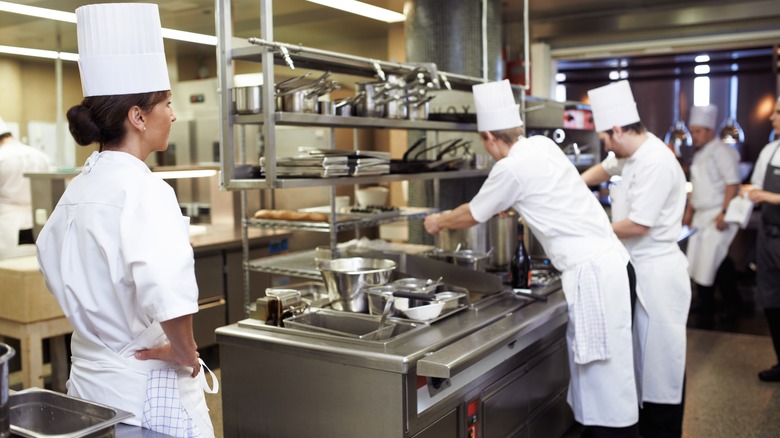Why Spaghetti & Meatballs Always Taste Better At A Restaurant
Spaghetti and meatballs is a classic. The perfectly cooked noodles, the flavorful red sauce, and the juicy meatballs all come together to make a whole greater than the sum of their parts. You might have a favorite restaurant version, but when you try to make it yourself at home, it just isn't the same. Maybe you attempt a bunch of recipes and techniques and no luck — the results you want always elude you. Why is that?
I gave myself the mission to get to the bottom of why spaghetti and meatballs always taste better at a restaurant. As a half-Italian food writer and recipe developer, I'm no stranger to pasta dishes. However, I wanted to hear from some professional Italian chefs about what makes their spaghetti special, so I interviewed three chefs from Italian restaurants to get the lowdown. Naturally, each of them has their own recipes and techniques, but it helped me get an idea of what's important in a good version of this dish.
Based on my conversations with chefs, I've outlined why homemade spaghetti and meatballs aren't the same as restaurant versions. Their answers can also tell you how to up your game and improve your homemade offerings. The only thing they didn't tell us is how to eat spaghetti like an Italian.
Chefs pay attention to the quality of the tomatoes in the sauce
The sauce can make or break spaghetti and meatballs, so it's important to get it right. When you make it yourself at home, you probably use whatever types of canned tomatoes you have on the shelf. This is fine for making decent sauce, but if you want to make great sauce, it's not going to cut it. Chefs think carefully about the quality of the tomatoes they use, and this is why good restaurant spaghetti and meatballs is always better.
Chef Vito Gnazzo of Southern Italian restaurant Il Gattopardo in New York City tells us he uses San Marzano tomatoes in his sauce. "These tomatoes are central to our cuisine and are known for their rich flavor, which shines through in our dishes," he explains. But he's serious enough about his sauce that he doesn't just grab tomatoes at the store. "I grow and preserve these tomatoes at my farm in Hudson Valley, ensuring that each sauce is made with the freshest, most flavorful produce, capturing the essence of Italian culinary tradition."
Vincenzo Adamo, chef at another NYC Italian restaurant, The Leopard at des Artistes, also pays a lot of attention to the tomatoes in his spaghetti sauce. "I like to combine different types of tomatoes to create a rich and complex flavor profile," he says. "I primarily use San Marzano, Corbarino, and Piennolo tomatoes, each bringing its unique characteristics to the sauce."
There are usually fresh herbs in the sauce
When making spaghetti sauce at home, you might reach for dried herbs. Or, worse yet, that little bottle of Italian seasoning. Dried herbs and spices don't stay fresh as long as you think, though, meaning they're not the best at importing flavor. Plus, they just taste different from fresh herbs. At restaurants, you'll usually find some fresh herbs in the tomato sauce used to make spaghetti and meatballs — and therein lies one of the differences.
Each chef has their own herb choices and uses them in their own ways, but there are some obvious choices for Italian food. "I use tons of fresh basil," Chef Vincenzo Adamo tells us. "It complements the tomatoes perfectly." Chef Lauren DeSteno, executive chef at Ai Fiori in Manhattan, has a different technique. "We steep basil in the sauce at the end of the cooking time," she explains. This avoids overcooking the herb and having it lose its flavor. Additionally, "we add basil and parsley to the pan when we pick-up the dish during service," she notes.
Chef Vito Gnazzo also makes use of fresh herbs. "Usually, for spaghetti sauce, we only use fresh basil," he says. "The basil we use is often picked directly from my farm, adding a fragrant, freshly plucked element that enhances the sauce's natural flavors."
Chefs know how to balance flavors
One of the reasons why restaurant food is often better than anything you could throw together at home is that chefs know how to balance flavors. A great dish has the perfect amount of tartness to balance the sweetness and the right combination of flavors so that the dish becomes more than the sum of its ingredients. It takes skill and practice and it's probably not something you've ever considered doing.
So, how do chefs make it happen? It varies from chef to chef, but our experts have given their insights. "We make sure that there is enough salt, acid (from white wine), and fat (from olive oil)," Lauren DeSteno of Ai Fiori tells us. "We also like to add some chili to round out the flavor, but not make the dish too spicy."
Vito Gnazzo of Il Gattopardo states that a minimalist approach to ingredients helps with getting the perfect balance of flavors. "The balance also comes from the freshness of the ingredients; each one is allowed to shine in its own right, creating a balanced dish," he adds. Vincenzo Adamo of The Leopard at des Artistes has other ideas when it comes to balance. "It's crucial to choose the right tomatoes, ensuring they are sweet enough," he says. "The sauce should be cooked for a long time to develop and meld all the flavors."
There may be wine in restaurant spaghetti and meatballs
The missing ingredient in your homemade spaghetti sauce might be wine. It's something that some chefs use in their sauces to elevate the flavors, but the type of wine varies. For instance, Chef Lauren DeSteno uses white wine in the sauce she puts together for the spaghetti and meatballs at her restaurant. However, the rich, deep flavors of red wine makes it a common addition to spaghetti sauce.
It's also worth noting that not all chefs choose to use wine in their sauce. "I believe in letting the natural sweetness and acidity of the tomatoes shine without the influence of wine," Chef Vincenzo Adamo tells us. So, it's not an essential ingredient, but it is one that could have made its way into your favorite restaurant spaghetti and meatballs.
If you choose to use it in your home recipe, there are many mistakes you can make when cooking with wine. Choose the wine carefully to complement the recipe and be sure to add it at the right point in the recipe to make the most of the flavors.
The sauce-to-pasta ratio is considered
Have you ever had a pasta dish where there wasn't enough sauce and the noodles were horribly dry? Or, conversely, where there was so much sauce that it felt more like a thick soup than spaghetti. At restaurants, chefs consider the ratio of sauce to pasta to give you the best experience.
"The sauce-to-pasta ratio is crucial in ensuring that each bite is balanced, allowing the pasta and sauce to complement each other perfectly without overpowering," Chef Vito Gnazzo tells us. Chef Vincenzo Adamo agrees, adding "just like everything in the kitchen, the dish needs to be perfectly balanced. The sauce-to-pasta ratio is critical in achieving that."
While none of our experts told us their exact sauce-to-pasta ratio, you need enough to fully coat the pasta with a little to spare. But not so much that there's more sauce than noodles. The sauce and pasta should always be mixed together, and you shouldn't top plain pasta with sauce and mix it as you eat. It's also a good idea to add a little pasta water when you mix the spaghetti and sauce together. The starch in the water helps the sauce cling to the noodles and gives it a silky texture.
The pasta is made in-house or meticulously selected
When you make spaghetti and meatballs at home, you probably don't think too carefully about the pasta you use. You might just pick up whatever spaghetti's on sale at your local grocery store and leave it at that. However, when you eat the same dish at a restaurant, the pasta might have been made fresh in-house. Or, where the chef prefers to use dried pasta, it will have been carefully selected.
At Ai Fiori, Chef Lauren DeSteno says the pasta is fresh and made in-house. But, not everyone likes to use fresh pasta for this dish. "Fresh pasta and dried pasta are very different items," Chef Vito Gnazzo explains. "In southern Italy, we tend to use dried pasta from Gragnano, which is one of the best. But there are so many good quality pasta available on the market."
"I personally prefer using dried pasta, especially the Trafilata in Bronze from Gragnano in Campania, Italy," Chef Vincenzo Adamo tells us. "It has a perfect texture and holds the sauce beautifully." That said, there are some times when he might opt for fresh pasta. "When I do use fresh pasta, I make it in-house to ensure the quality is just right," he remarks.
Chefs cook their spaghetti al dente
If you've loved the texture of pasta at a restaurant, it might be because it's cooked al dente — with some bite to it — rather than so it's soft and limp. This can make the difference between exceptional spaghetti and meatballs, and a dish that's perfectly nice but not particularly memorable.
"As an Italian, I always cook my spaghetti al dente," Vincenzo Adamo remarks. Vito Gnazzo is a little more measured in his response, but largely agrees. "It depends on the sauce you are planning, but generally, al dente is the way to go," he says. "The texture of al dente pasta provides the perfect contrast to the rich, flavorful sauces we create, enhancing the overall experience."
If you struggle to cook your spaghetti so it still has some bite to it, there's a foolproof technique for al dente pasta. All you need to do is check it after 8 minutes, as pasta is often ready sooner than the package suggests it will be. Some chefs even drain the pasta slightly before it reaches al dente and then cook it in the sauce for the last couple of minutes. This helps to meld the flavors for an even tastier dish.
The meatballs are carefully seasoned
The surprising truth about spaghetti and meatballs is that it isn't actually Italian. It's a dish created by Italian immigrants to America. So, it's more of an Italian-American dish than one that originates from the motherland. Still, that doesn't stop it from having a rich history — and being a favorite among many.
The meatballs are all-important. They're what transforms the dish from spaghetti with marinara sauce into something else. And, according to the chefs we spoke to, the way they're seasoned is crucial. This doesn't mean there's one right way to season meatballs and all the others are wrong, but chefs potentially pay more attention to the types of seasonings used and how they're balanced than most people do when cooking at home.
"We use breadcrumbs, pecorino cheese, eggs, and parsley, all of which are selected with the utmost care to ensure that the flavors are rich and authentic," says Chef Vito Gnazzo of Il Gattopardo in NYC. Chef Vincenzo Adamo has a different seasoning technique at The Leopard at des Artistes. "I season my meatballs with a mix of garlic, nutmeg, parsley, salt, and black pepper," he informs us.
Finishing touches are important
When you're making dinner at home, you probably finish up, chuck it on a plate, and dig in. But, that's part of the difference between a restaurant-quality meal and one you make yourself at home. Chefs know the importance of finishing dishes carefully. Even if the finishing touches are only simple, they can elevate the dish to another level of deliciousness.
"I finish the dish with fresh basil and a generous sprinkle of good Parmigiano Reggiano," says Chef Vincenzo Adamo. "These final touches elevate the dish, adding freshness and a savory depth." Parmigiano Reggiano is also Chef Vito Gnazzo's finishing touch of choice. "This final touch adds a layer of depth and complexity, enhancing the flavors of the dish," he tells us.
So, even if it's as simple as a sprinkling of fresh herbs and a generous grating of Parmesan, paying attention to how you finish your dish can make all the difference. Of course, you can also experiment with other hard cheeses. For instance, maybe you prefer Pecorino Romano or Grana Padano. A drizzle of high-quality olive oil doesn't go amiss, either, adding some richness to the finished dish, along with peppery notes. Plus, you might want to pay attention to how you plate the meal, arranging it carefully rather than just piling it haphazardly.
Ingredient quality is at the forefront
As a rule, a good chef cares deeply about food and wants the dishes they're serving to contain great ingredients. This plays a big role in why restaurant food is often better than homemade. You probably don't spend hours poring over various types of olive oil or finding the perfect source for sweet, delicious tomatoes.
Chef Vito Gnazzo believes that choosing quality ingredients is the only way to create a great dish. "My philosophy is rooted in using the highest quality ingredients, whether they are locally sourced or imported from Italy, to ensure that every dish we serve at Il Gattopardo is exceptional," he tells us. At the restaurant, they only use extra virgin olive oil from Italy. "I also carefully source ingredients, many of which are grown on my farm," Gnazzo says. "This direct involvement with the farming process ensures that every ingredient is of the highest quality."
We also heard from Chef Vincenzo Adamo about how important ingredients are in the culinary world. "Ingredient quality is key in my cooking," he explains. "A significant part of my job as a chef is sourcing the best products from around Italy."
There's a focus on simplicity
Simplicity is at the heart of Italian cuisine. While some cuisines rely on rich, indulgent ingredients or big punchy flavors, Italian fare is about taking simple ingredients and combining them with care and attention, making the resulting dish taste more amazing than you'd expect for what went into it.
"Less is more," Chef Vito Gnazzo tells us, when making the perfect spaghetti sauce. If you haven't been pleased with the results you've been getting at home, you might have been trying to cram in too many flavors. A great dish relies on quality ingredients and careful cooking methods doing a lot of the work — you don't need to use every herb on your spice rack.
Gnazzo adds that part of what makes his sauce special is the simplicity. "Using fresh quality ingredients can take any simple meal and make it exceptional," he says. Chef Vincenzo Adamo agrees that simplicity is at the core of making restaurant-quality spaghetti and meatballs. He, too, believes that using quality ingredients is what elevates the dish.
Chefs have skill and experience home cooks can't match
There's one factor that many people forget when they wonder why a dish was so much better at a restaurant: chefs are trained professionals. That's part of why people are willing to pay more to eat food at a restaurant — it's made by someone who knows what they're doing.
Many chefs have been to culinary school or, if not, they've trained on the job. They have to spend years working their way through the ranks until they become a head chef or executive chef. So, it's likely that the recipe you love so much has been created by someone with extensive training and years of kitchen experience under their belt. That's not something you can simply pick up by following a recipe.
There's a lot of nuance to cooking. It's about knowing when things need adjustment rather than blindly following a recipe. For instance, a chef might know when the tomatoes they're using aren't quite as sweet as usual and the perfect quantity of sugar to add to balance it out. It's these kinds of things that might seem small but can make all the difference to the finished dish. Ultimately, if you want the best ever spaghetti and meatballs, you might just have to head to your favorite Italian restaurant rather than try and recreate it at home.
